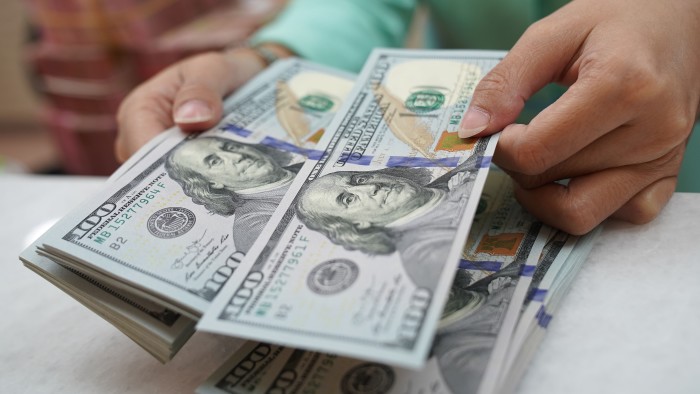Unlock the White House Watch newsletter for free
Your guide to what the 2024 US election means for Washington and the world
Markets are underestimating the risk of a neck-snapping shift in the global financial regime under Donald Trump, with the dollar at its centre.
The US currency has backed down from its post-election high, reaching a two-month low against a basket of other currencies at the start of this week, even despite the latest surprisingly strong inflation data. That is likely to be somewhat soothing for the president, who has spent years railing against what he sees as the corrosive impact on US manufacturing of an overly strong buck.
But by any sensible measure the dollar is still strong. The days when the euro traded steadily around $1.30 and sterling at $1.60 are far behind us — try $1.04 and $1.26 on for size instead. The dollar index has risen some 15 per cent over the past decade.
Up to now, the mantra in markets has been: don’t worry, the US would never do anything outlandish to try and force the currency lower. One month in to the new president’s reign, it is time to question whether that assumption still makes sense.
Convention and tradition are certainly not holding him back in other areas. On geopolitics, diplomats and foreign policy wonks have learnt this the hard way. Decades of carefully curated alliances have gone out of the window in what Trump’s supporters describe as an altruistic pursuit of peace in Ukraine.
At home, the new administration is no less disruptive. Trump has unleashed the world’s richest man, Elon Musk, on the inner workings of the federal government, where his libertarian acolytes are busily ripping out the wiring. Not even the Federal Aviation Administration is spared in the spending cutbacks.
In financial markets, investors are looking on with bemusement verging on outright approval.
US stocks punched through to yet another record high this week. Are government bond investors alarmed about the challenge to cherished checks and balances at the heart of government? Apparently not. Some large global reserve managers are jittery, judging from a pullback in demand for Treasuries after election day and a rampant ascent in the price of gold, but the stumble in bond prices at the start of this year has dissipated. No sign of a crisis — fiscal, inflationary or any other flavour — there. It turns out the bond market is happy to see federal spending reduced, by whatever means Musk and his so-called Department of Government Efficiency deem necessary.
In sum, for now, investors are viewing the freewheeling, norm-busting, alliance-denting disruption of Trump 2.0 as a political circus, not something for them to worry about.
In the currencies markets too, the president’s policy stance is not cutting through. Some of the messaging here has been tricky to parse. Treasury secretary Scott Bessent told Fox News last week that the US’s strong-dollar policy “doesn’t mean that other countries get to have a weak-currency policy” — hardly a clear signal to sell the buck.
But Trump’s conviction that dollar strength gives trading partners an unfair advantage is well known, and the hottest document in financial markets — an essay published last year by presidential adviser Stephen Miran — shows that economists close to the president are of the same mind.
Miran’s essay is studded with radically unorthodox ways in which Trump and his administration could look to rework the financial system, explicitly tying foreign governments’ input into US federal coffers to preferential terms on trade and even security. Within that, a significantly weaker dollar could well emerge as an aim in itself.
“Consensus on Wall Street is that there is no unilateral approach that the Trump administration can take for strengthening of undervalued currencies,” wrote Miran. “This conclusion is wrong.”
Miran is right to suggest that up to now, market participants have laughed off the idea of a serious effort to weaken the dollar. It simply cannot work, they argued, without aggressive US interest rate reductions that risk letting inflation rip, some kind of agreement among other countries to sacrifice self-interest at the feet of US industrial policy, or the establishment of vast US reserves used to hose the dollar down. Six months ago this all seemed absurd. Would you really bet against it now?
If Trump is bold enough to put Nato in jeopardy, he is bold enough to do the same with the foundations of the financial system. Calm markets have given the signal that radical, unpredictable domestic and foreign policy is fine, actually. Investors should not assume an emboldened president will tread lightly on the dollar either.

















